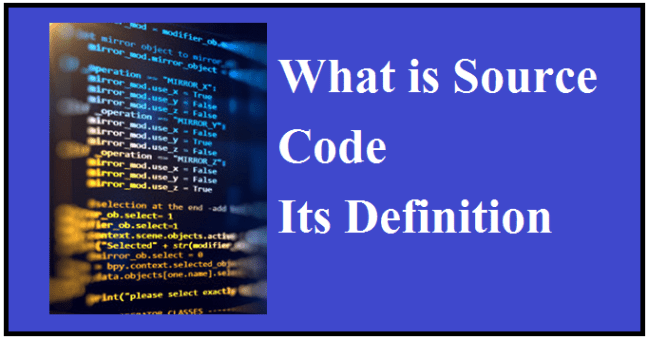What is source code Its Definition
What is source code? Purpose of source code

Source code is a set of instructions and statements written by a programmer using a computer programming language. This code is later translated into machine language by a compiler. The translated code is referred to as object code.
What is Source Code? – Purpose of Source Code. Definition, in English[What is source code? Purpose of source code]. definition
Every computer program is written in a programming language, such as Java, C/C++, or Perl. In these programs, from a few lines to millions of lines of text, is called source code.
Source code, often referred to as the “source” of a program, consists of variable declarations, instructions, functions, loops, and other statements that tell the program how to act. Programmers can also add observations to their source code that explain sections of the code. These observations help other programmers to understand what to consider in the source code at least without needing hours to understand it.Comments can be helpful to the original programmer and even if several months or years have passed since the code was written.
Short programs called scripts can be run directly from the source code using a scripting engine, such as VBScript or the PHP engine. However, most large programs require that the source code be first compiled, which translates that code into a language that the computer can understand. When changes are made to the source code of these programs, they must be recombined in order to be effective in the program.
Short programs may use only one source code file, while large programs may reference hundreds or even thousands of files. Having multiple source files helps to organize the program into different sections. Having one file containing each variable and function can make it difficult to locate specific sections of code. No matter how many source codes are used to create the program, you won’t be able to view any of the original files on your computer.This is because they are all combined into a single program file, or application, when they are compiled.
History of Source Code



Determining the historical beginning of source code is a subjective – and elusive – exercise. The first software was written in binary code in the 1940s, so depending on one’s point of view, such programs may be early samples of source code. One of the earliest examples of source code as we recognize it today was written by Tom Kilburn, an early pioneer in computer science.Kilburn created the first successful digital program held electronically in a computer’s memory in 1948 (software solved a mathematical equation).
In the 1950s and 60s, the source code was often provided free of charge along with the software by the companies that made the program. As growing computer companies expanded the use of software, source code became more prolific and sought after. Counting magazines before the Internet age would often print the source code in their pages, with readers rewriting the code character for character for their own use.Later, floppy disks reduced the price for electronically sharing source code, and then the Internet removed these barriers.
Purpose of Source Code
Besides providing the basis for software creation, source code has other important purposes as well. For example, skilled users who have access to the source code can easily customize the software installation, if required.
Meanwhile, other developers can use the source code to create similar programs for other operating platforms — a task that would be trickier without coding instructions.
Access to source code also allows programmers to contribute to their community, either through sharing code for learning purposes or recycling it for other applications. re-cycle).
